A while ago, I wrote an article called "Step by Step Face Parts". I had gotten a few replies about it, saying it was helpful. But when I went to re-read it, myself, I realized that it's a little out of date, if you know what I mean. So I decided to write another article, and hopefully you guys will find it a little more helpful than the last. I'm going to go into a little more detail this time around. My last article was step-by-step to making a face part; this time around, it's a step-by-step to becoming a designer.
So I'm sure most of you are thinking, "Where do I start?" First of all, you need a Whypass or a Face Factory Voucher. If you're planning on just making a few parts, then Face Factory Vouchers are good. But if your dream is to be a big time Whyville designer, then getting a Whypass would be best (I'm sure you can convince your parents to buy you one if you do some chores :-)). If you don't have one of these two, you won't be able to enter the Face Factory, so there's not much point in reading this article unless you are planning on getting one.
For those of you who are planning on using Face Factory Vouchers and haven't yet seen what the inside of the factory is like, I will tell you what to expect. When you click "Akbar's Factory" on the Whybus menu, it will take you to a screen that will allow you to choose whether you want to manage your designs, or your stores. You can also access Akbar's Face Factory by going to Sector Y. If you're just starting out, you should make a few face parts before you open a store, so let's start at the "Designs" category. There will be four links: Create new designs, Manage Existing Parts (where you can restock, re-price, or put your parts into a different store), Continue a saved design, and Delete designs. So, obviously if you're only just starting out, you want to press the "Create new designs" button.
In this screen, it is important to read what Akbar has to say. Rules and guidelines are crucial, because there's no point in complaining about something, such as you didn't get a refund, when Akbar never said you would get one. So read what Akbar says about how it works, and if you need some helpful hints from other Whyvillians, there are a few articles for you to look at. But hopefully I will cover most of what you need to know right here. So now, "Let's Get Started:", you need to choose a category, a name and a size. You will get a chance to change the name if you think of a better one after you create the part. There are four canvases to choose from:
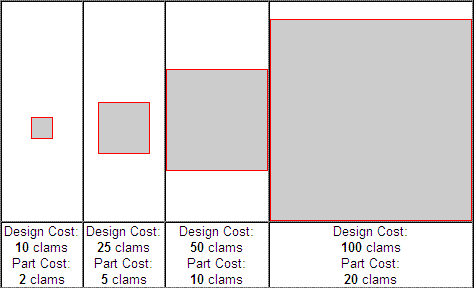
When you create a part, you need to restock at least four of them. So the most clams you will need is 180, if you are planning on using the largest size. If you have that much, then your good for the other sizes as well. Because it wouldn't be very smart to buy a Face Factory Voucher from someone and not even have enough clams to make anything once you get there, would it?
So once you pick your canvas size, you will have access to a screen that looks like this:
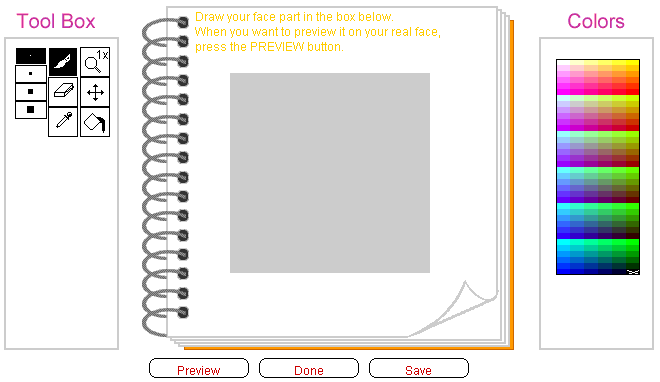
For tools, you have four brush sizes, an eraser, an eye dropper to match colors without having to find it again on the palette, a zoom button, a drag button, and a paint can to fill in large spaces. The "Preview" button lets you see what the face part is going to look like on your avatar, so that you can get proportions right. As for the "Done" button, someone once told me, "Never press the 'Done' button unless you think you'd wear it yourself". In other words, if you don't think your design good enough that you'd wear it, then don't expect other people to; keep working on it. Some things take time, and if you don't have that time, you can always press the "Save" button and come back to it later.
What now? I'll going to give you a few designing tips. Designing isn't as easy as drawing a pretty picture and selling it in Akbar's mall. You have to go into great detail; that's how you get the best quality face parts. My favorite thing to make is hair, so I will use hair designing as an example.
I'm sure a lot of you future designers will discover your own process of designing face parts, but for now, I'll show you how I do it. I always start off with a rough sketch; this part doesn't matter too much, it's just to get the proportions right. Then I'll preview it until it's a good size.

Next, touch it up a little. For this, I like to zoom in a little, it gives you more control and precision. I also like to use the smallest brush size, because you can get sharper tips and more precise lines. Because hair doesn't abruptly stop in thick square pieces, does it?

So now that you have a nice base for your hair, it's time to start modeling it. Modeling means to give a two-dimensional image three-dimensional characteristics. In other words, shading. This part is probably the most tricky, although, some designers don't even bother with shading, they just add different colored streaks to match the form. In this way, line is very important; the lines need to match the shape of the hair. You don't want to have a straight hair base with wavy hair pieces inside, it wouldn't look right. Shading can also be tricky because the lighter you get, the more option you have to change the color.
For instance, in this example, the hair starts off as a blue tint, but as it gets lighter, it turns purple and then magenta, making the hair look like it has a purple tint. And on the other side, it starts off with a brown tint, but then works it's way to red, and some streaks even look orange. But it actually started off being black. How did that happen? Take a look for yourself. Many different shades are used, and the slightest change in the color on your way up (like a more blueish purple compared to a redish purple, or a orangey red compared to a crimson red) can give it a completely different look.
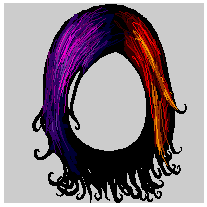
Besides color, another challenge with modeling an image is knowing where the light source is. This is probably the most challenging aspect to new designers, but I will tell you what I mean by light source. Let's pretend the light is coming from directly above.
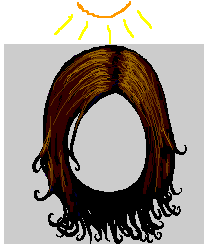
As the hair gets closer to the light, the shades get lighter. Also notice how the lines follow the shape of the hair and give it a smooth form. The part in the hair where it separates isn't very close to the light, and is shaded darker. It really makes it look three-dimensional when you think about it this way. Here are some more examples of how light sources can work.
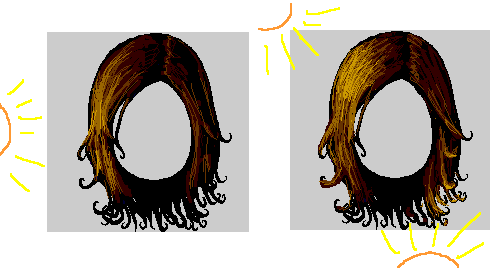
Another challenge people have with hairstyles, is the actual hairstyle itself. You see how the hairstyle I chose isn't completely straight, it's actually kind of curly. Notice how the lines follow that idea. But for some styles, you'll need to look at a picture source. Here are some examples of designs taken from picture sources:
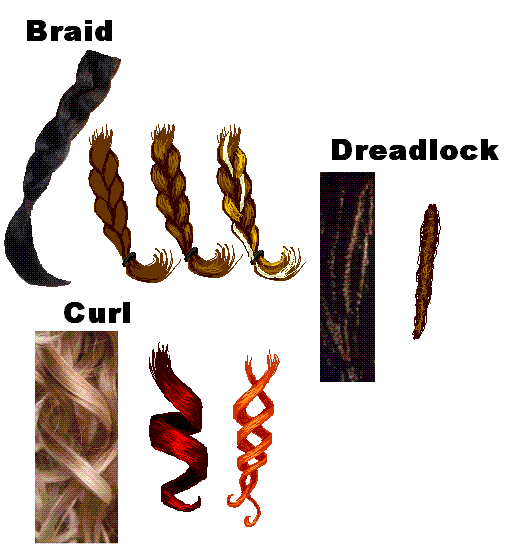
The braid is made of three strands of hair (which I have separated with different streaks so you can see how the intertwine). Curls are sort of like flat ribbons twisted around an invisible cylinder. Again, notice how the direction of the lines follow the shape of the form. Dreadlocks are an exception for the whole idea of modeling the form by the direction of line, because they have a different texture than smooth silky hair, they're more messy and scribbly. To make dreadlocks fall nicely into a head-shaped form, think of each strand as a singular rope, and work from there.
As for other face parts (shirts, eyes, lips, etc.), it's basically the same process. Think of an idea, make a rough sketch, polish it up to a nice shape and make sure it's in proportion with your avatar, model it by picking a light source and shading it in with different tones and colors, and pay attention to texture, whether you want it to be glossy, metallic, fuzzy, etc. (you may need picture sources to get those to look right).
Don't be upset if your designs didn't quite turn out like the examples. Everybody has a different style. For instance, some people like making more cartoony looking parts. They use solid shapes to model the form with few different shades. Some people like making things look more realistic, with more gradation (meaning, gradually advancing from dark to light using many different tones rather than just a few) and thinner whispier lines. For example, look at these two shapes:
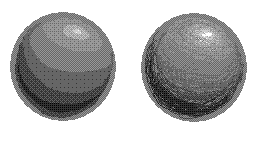
The first one is made of shapes of different shades of gray, shaped to make the circle look like a sphere in a cartoon-like way. The second shape is made of thin lines and many shades of gray to shape the circle into three dimensions more realistically.
It all depends on your own preference. Some people like to do a combination of both cartoony and realistic. With a bit of practice and experience, you'll probably discover which works best for you, or if you'll think of something completely different. Everybody has their own style, not just with the shading, but with the shapes and general ideas. Maybe one day people will be able to see one of your designs and say "Hey, that looks like something _____ would make!"
So now you have a finished face part. But is it really finished? Take a closer look, do you think it's something you'd wear? Make sure all the edges are smooth (unless the texture calls for it to be uneven). This is extremely important for making hair and shirts, because humans have naturally smooth and symmetrical curves, not unevenly warped curves. So make sure the face shape of your hair and the neck of your shirts curve smoothly and symmetrically. Make sure there aren't any stray pixels you forgot to erase. Make sure it looks good on your avatar and is in proportion. Maybe you need a little more detail. A glossy shine for your lips, a pattern or symbol for your shirt, a few more strands here and there for your hair, or a twinkle in the pupil of your eyes, whatever you think might enhance the design. Now that your design is polished, it's time to finally press the "Done" button.
This will take you to another screen with your design in a smaller box. Yes, you aren't done yet. You need to make sure that everything still looks nice in the smaller screens, because you don't want to put all that effort into making a beautiful design and then have half of the pattern disappear when it was shrunken to smaller sizes. The reason this happens is because of the pixels; you can only have a certain amount for each view, and when you shrink the canvas, you don't have as many pixels to work with, so you need to work around it and make sure each view looks right (there will be four different views for your design).
So now you're finally done your design. Give it a name and a price (the highest you can go is what your salary is). You have to stock at least four parts when you create a design, but you can stock up to 50. After it gets accepted, it's up to you how many you want to restock at one time. You can also choose which store to put it in, which brings me to the second category you'll see when you first enter the Face Factory; Stores.
You will see a list of options that say Create New Store, Assign To Store, Manage Your Existing Stores, and Allow Friends To Stock Parts In Your Store. When you create a new store, you need a catchy name and a description. You can choose which friends in your address book you'd like to have access to your stores (meaning, whenever they create a design, they have the option of stocking it in your store). This can be useful if you're just starting out and don't have many designs, because it's not much fun shopping in a nearly empty store, is it? You can also promote your stores by bidding for a spot on the front page of Akbar's Face Mall. Usually you need to bid anywhere from 200-500 to get a spot, and sometimes up to 3000 if you want to be the first on the list.
So now you know how to run a business in the Whyville fashion industry. But there are a few rules and guidelines that I should point out. Akbar does not accept designs that are trademarks (for instance, a plushie of a character from a cartoon television show, or a band shirt). He also doesn't accept pacifiers, extensions, cover-up, or weapons of any sort. There has been some issues with designing shirts with long waists and necks, because people will put the long necks over the belly, making it look like a belly shirt, which doesn't follow the Whyville dress code. So be careful with your shirt designs. Also be careful with your hair designs, because he won't accept it if the face hole is too small.
So there you go, a step-by-step to becoming a Whyville designer. It will be frustrating at first, because drawing on a computer screen with a mouse can be very tricky, but you'll get used to it with practice. Only time can bring out your skills. And don't worry if you aren't much of an artist in real life; Whyville can be a good place for you to begin to practice your skills. Anybody can draw if they want to, they just need to spend the time training their eye to recognize things like proportion and modeling without much thinking. It takes longer for some people than others, but everyone can do it, even you. So don't ever get discouraged and give up, you could be the next biggest Whyville designer next year!
Thanks for reading, I hope I've helped you guys out. But these are just tips and guidelines, not rules that need to strictly be followed. That wouldn't leave much room for your own creativity, would it? So always remember: don't be afraid to let your imagination run wild.
~Twigsy.